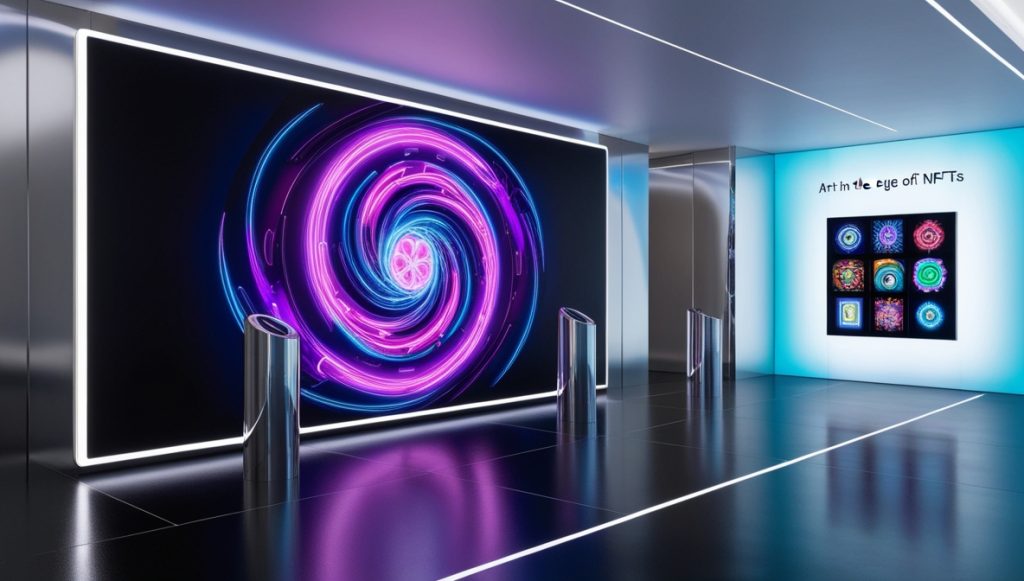The rise of NFTs (Non-Fungible Tokens) has radically transformed the landscape of digital art, giving artists new ways to monetize their work and engage with collectors. NFTs have sparked a new era where digital art, once considered difficult to own and trade due to its intangible nature, has become a highly valued asset. As the art world increasingly embraces blockchain technology, NFTs are not only shaping the future of digital art but also redefining how we think about ownership, value, and the artist-collector relationship.
What Are NFTs?
NFTs are unique digital assets that exist on blockchain technology. Unlike cryptocurrencies like Bitcoin or Ethereum, which are fungible (each unit is identical to the other), NFTs are non-fungible, meaning each token is distinct and cannot be replaced by another. NFTs can represent ownership of various digital assets, such as images, videos, music, or even virtual real estate. In the context of art, NFTs allow artists to create verifiable ownership and provenance for their digital works, making them collectible in the same way physical art has been for centuries.
How NFTs Revolutionized Digital Art
Before NFTs, digital art faced significant challenges regarding ownership, distribution, and value. A digital image or video could be endlessly copied and shared online, making it difficult for artists to retain control over their work or profit from it. NFTs solve this problem by embedding proof of ownership directly into the artwork through the blockchain. The buyer of an NFT holds the original, certified copy of the digital artwork, even if multiple copies are available on the internet.
This new model has revolutionized the art market. Artists can now sell their digital works as unique, scarce assets, similar to physical paintings or sculptures. This has opened up unprecedented opportunities for digital artists, many of whom were previously underrepresented in the traditional art world. Moreover, NFTs enable artists to receive royalties each time their work is resold, which is impossible in the traditional art market.
The Rise of NFT Marketplaces
NFT marketplaces, such as OpenSea, Rarible, and Foundation, have quickly become hubs for buying and selling digital art. These platforms allow artists to mint (create) NFTs of their work and list them for auction or direct sale. For many artists, this has democratized access to the art market, enabling them to reach global audiences without the need for galleries or agents.
The accessibility of these platforms has also led to a diverse range of artists entering the NFT space, from well-established digital creators to emerging talent. Popular NFT artists like Beeple, whose work Everydays: The First 5000 Days sold for a record $69 million at Christie’s, have garnered attention for their innovative approaches to digital art. This level of exposure and income generation was previously unimaginable for most digital artists, marking a significant shift in the value of digital artwork.
Redefining Ownership and Collecting
NFTs are reshaping how collectors approach art ownership. In the traditional art world, ownership is tied to physical objects—paintings, sculptures, or photographs. With NFTs, collectors are purchasing ownership of a digital file. This may seem counterintuitive to those accustomed to physical artworks, but the blockchain ledger provides irrefutable proof of authenticity and ownership, even for digital pieces that can be viewed or downloaded by anyone online.
For collectors, owning an NFT is not just about holding a file—it’s about holding a certified, original piece of digital art. The transparency of the blockchain allows collectors to verify the provenance of the work and track its entire sales history. In some cases, collectors gain exclusive perks, such as access to additional content or membership in special online communities.
Additionally, NFTs often come with built-in smart contracts, enabling artists to receive a percentage of future sales. This ensures that artists continue to benefit from the increased value of their work, something that is virtually impossible with physical art. For collectors, this provides a more equitable model for investing in art, knowing that their purchase continues to support the artist.
The Role of Community and Collaboration
NFTs have also given rise to new forms of collaboration and community engagement. Artists and collectors can directly interact through social media and NFT platforms, breaking down traditional barriers between creators and buyers. This direct interaction often fosters a sense of community and shared enthusiasm for digital art.
Collaborations between artists have also flourished in the NFT space. Musicians, visual artists, and digital creators can easily collaborate on projects, minting unique NFTs that blend various art forms. These collaborations further blur the lines between different creative disciplines and offer a new dimension to how art is experienced and appreciated.
Challenges and Criticisms
Despite the opportunities NFTs provide, the technology is not without its challenges and criticisms. One of the primary concerns is the environmental impact of NFTs. Blockchain transactions, particularly those on the Ethereum network (the most widely used for NFTs), require significant energy to process. This has led to concerns about the carbon footprint of NFT transactions, prompting some artists and collectors to call for more sustainable blockchain solutions.
Additionally, the speculative nature of the NFT market has raised concerns about its long-term viability. The rapid rise in NFT sales has led to fears of a bubble, where prices for digital art could crash just as quickly as they’ve risen. While some view NFTs as a revolutionary way to own and trade art, others are skeptical about whether the current levels of interest and value are sustainable.
The Future of Digital Art
The rise of NFTs marks a pivotal moment in the evolution of digital art. While it remains to be seen whether the NFT market will continue to grow at its current pace or face a correction, the underlying technology has already fundamentally changed how we think about ownership, value, and creativity in the digital age. For digital artists, NFTs offer unprecedented opportunities for financial independence, exposure, and creative freedom.
As blockchain technology advances and more environmentally friendly solutions emerge, NFTs will likely become an enduring part of the art world. Whether collectors and artists fully embrace this shift, one thing is clear: NFTs have permanently altered the way digital art is created, bought, and experienced. The future of digital art is here, and it’s being shaped by the rise of NFTs.



